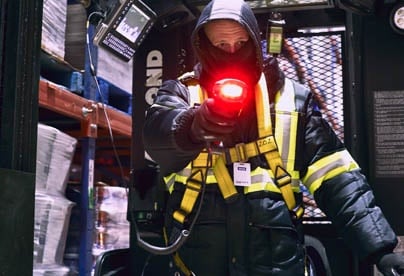
Safety in the workplace is something we take very seriously at VersaCold, especially when working from heights, where accidents caused by hazards can be much more dangerous. The potential dangers of operating a ladder can range from falling off the ladder, being struck by the ladder or even tripping over the ladder. No matter how you slice it, ladder-related accidents are very common yet entirely preventable. However, just like most things when it comes to safety in the workplace, prevention of accidents is dependent on workers recognizing hazardous conditions and taking preventative steps to avoid them.
Quick Tips
Tip #1
Check a painted wooden ladder extra carefully for defects and signs of damage before use because paint could be hiding a potentially dangerous hazard that might not be clear at first glance.
Tip #2
Never attempt to reach for something while on a ladder. It’s always safer to get off the ladder, move it and then climb back up.
To help you avoid these potential hazards, we have outlined four mistakes commonly made when operating a ladder and how you can avoid making them. For more workplace safety tips, check out Material Handling Equipment (MHE) Safety: Are You Following These Best Practices? and 6 Proven Safety Tips That Prevent Slips and Falls.
- Using a worn or damaged ladder
An important step to take before any job is to inspect the ladder you are about to use to ensure it’s in optimal condition. A common contributor to ladder accidents is the use of damaged or worn-out ladders that have far outlived their usefulness. Like every tool in the workplace, constant use can break down a ladder and lead to accidents. Damaged or defective ladders are extremely dangerous, and using one could result in injury or damage to property, so be thorough with your check. Do not use any ladder that has missing parts or loose parts or one that sways or leans to one side. If you find any part of the ladder to be in poor condition, make sure to avoid using the ladder until it has been properly repaired or replaced.
- Improper use of a ladder
It is vital to only use the ladder in the way the manufacturer intended it. When using a ladder, it’s important to avoid altering the ladder in any way and to maintain three points of contact to ensure maximum stability. The three-point method ensures the user always faces the ladder and has three points of contact with the steps, rungs and/or side rails using their feet or hands. The user maintains this level of contact during the ascent, descent and while using the ladder for a task. To achieve this, it’s important that the climber has no objects in their hands that could interfere with a firm grip on the ladder. This can be accomplished by hoisting the materials to the top of the ladder or attaching them safely to a belt.
It is also important to always make sure you have someone who can support the base of the ladder while it’s in use. If this is not possible, you can stake the feet of the ladder into the ground if you are outside.
- Not inspecting the placement of the ladder
Many ladder accidents can be traced back to where the ladder was placed. Before positioning any ladder for use on a job, it is important to take the following into consideration:
- Is the ground firm and level?
- Is the ladder blocking an entrance?
- Is the ladder in front of a door?
- If the ladder is in front of an entrance or at risk of being touched unintentionally, is there someone who can guard the ladder while you use it?
If you can answer yes to all these questions, you should be safe to use the ladder in the location you chose.
- Using the wrong ladder for the job
Above all else, it is always important that you use the right tool for the job. The key to deciding if you made the right choice is 1) knowing the details of the job you need the ladder for and 2) understanding the capabilities of the ladder you are using. Questions you may want to ask yourself before choosing a ladder for a particular job are the following:
- What is the ladder height required to do the job safely?
- What is the maximum weight capacity of the ladder?
- Does the ladder have the capability of being supported by stakes or does it require an additional person to hold on to it for stability?
By knowing what the job needs and the tools you have available, you can pick the right ladder for the job.
Accidents caused by the improper use of a ladder can be a major source of serious injury in the workplace. To protect yourself and co-workers, it’s important to keep these tips in mind and avoid commonly made ladder safety mistakes.
Contact one of our Sales Specialists today and let us show you why we are the right choice for your business. sales@versacold.com or 1-800-563-COLD










